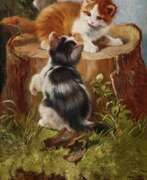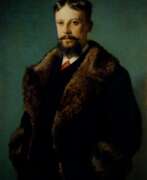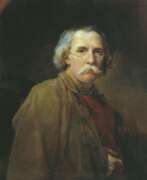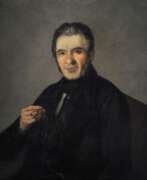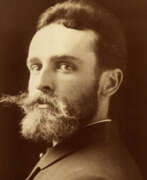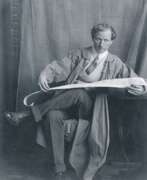Painters 19th century


Fyodor Yakovlevich Alekseyev (Russian: Фёдор Яковлевич Алексеев) was a Russian painter born around 1753 in Saint Petersburg. Known as the "Russian Canaletto" for his masterful vedute, or detailed paintings of cityscapes, Alekseyev made significant contributions to Russian art, particularly in depicting urban landscapes.
Alekseyev was admitted to the Imperial Academy of Arts in 1764, where he initially studied ornamental sculpture and scenic painting under Antonio Peresinotti. He spent several years in Venice, funded by a fellowship, where he studied theater painting but preferred creating landscapes and copying works by old masters. Upon his return to Russia, he faced restrictions but gradually gained recognition for his independent work. His notable painting "View of the Palace Embankment from the Fortress" earned him the title of Academician in 1794.
In 1800, Tsar Paul I commissioned Alekseyev to paint the streets and architecture of Moscow, resulting in numerous significant works that highlighted the city's grandeur. Despite a decline in fame later in life, his contributions to Russian urbanscape painting remain influential, with works such as "Red Square" and "The Flood of 1824 in the square at the Bolshoi Kamenny Theatre" held in major Russian museums like the State Russian Museum and the Tretyakov Gallery.
For updates on sales and auction events related to Fyodor Yakovlevich Alekseyev, sign up for our newsletter.


Antonio De Simone was an Italian marine painter.
He created many paintings depicting various ships at sea: frigates, yachts, sailing ships and steamships, in the storm and with the sails down. De Simone also painted historical battle scenes, such as his famous painting - "Bombardment of Alexandria", which is in the Royal Greenwich Museums.


Jenny Fikentscher (born Nottebohm) was a German painter and graphic artist associated with the Art Nouveau movement. She studied at the School of Women Painters in Karlsruhe and later became part of the Grötzingen artist colony. Fikentscher married animal painter Otto Fikentscher and raised five children in an unconventional artistic household. She was known for her botanical motifs and lithographs, often featuring local plants. Fikentscher also created collectible images for the Stollwerck chocolate company.


William Matthew Prior was an American folk artist known for his portraits, particularly of families and children.
About 1,500 portraits are attributed to Prior. His works are in many museums and institutions around the United States including the Harvard Art Museums, Museum of Fine Arts, Boston, and the National Gallery of Art.


Wilhelm Schmurr was a German painter and co-founder of the Sonderbund in Düsseldorf. His style, characterized by clear expression, was influenced by the Pre-Raphaelites, Symbolists, and Realists. He received several awards and medals for his work and was a member of various art associations. Schmurr taught at the Kunstakademie Düsseldorf and inspired by the farmers after the war, he created scenes of simple life and still lifes. He was awarded the Karl-Ernst-Osthaus-Preis and the Bundesverdienstkreuz erster Klasse and became an honorary member of various artist associations.


Giuseppe Abbati was an Italian artist, renowned for his role in the Macchiaioli movement. Born on January 13, 1836, in Naples, Abbati's early exposure to art came from his father Vincenzo, who specialized in painting architectural interiors. This foundational experience deeply influenced his initial works, which were primarily interiors. However, Abbati's artistic journey took a significant turn after losing his right eye in the Battle of Capua during Garibaldi's 1860 campaign. This event marked a period of transformation, leading him to Florence where he engaged deeply with the Macchiaioli group at Caffè Michelangiolo.
Abbati's contribution to the Macchiaioli movement was profound, characterized by a bold treatment of light and shadow, a technique he mastered by painting en plein air. His landscapes, such as the "View from the Wine Cellar of Diego Martelli" (1866), exemplify his skill in capturing the interplay of light, offering viewers a luminous landscape scene glimpsed through the doorway of a darkened interior. His works are celebrated for their unique perspective and are housed in prestigious collections, including several museums across Italy.
Tragically, Abbati's promising career was cut short at the age of 32, when he died in Florence from rabies, a consequence of a dog bite. Despite his brief life, his artistic legacy endures, influencing generations of painters who admire his innovative approach to natural light and landscape.
For enthusiasts and collectors keen on exploring Giuseppe Abbati's work further or acquiring pieces associated with him, subscribing to updates on new sales and auction events is highly recommended. Stay informed on opportunities to own a piece of this remarkable artist's legacy. Subscribe today for exclusive updates.


Louise Abbéma was a French painter, sculptor, and designer, celebrated for her work during the Belle Époque. Born in Étampes in 1853 into an affluent Parisian family, she became well known for her portraits, particularly of the famous actress Sarah Bernhardt, and for decorative panels commissioned for various public buildings in Paris and the Palace of the Governor in Dakar, Senegal.
Abbéma's art often depicted the upper echelons of French society and reflected the Impressionist style through her light and rapid brushstrokes. She was also notable for her involvement in the women's movement, where she contributed to the emerging image of the 'New Woman' by portraying androgynous figures and themes of intellectualism and freedom.
Among her many honors, Abbéma was awarded the Palme Academiques in 1887, nominated as the Official Painter of the Third Republic, and in 1906, she became a Chevalier of the Legion of Honour. Her works, such as "Lunch in the Greenhouse" and "Portrait of Sarah Bernhardt," have seen a resurgence in popularity as the contribution of women to historical art gains more recognition.
For those interested in the evocative and historically rich artworks of Louise Abbéma, consider subscribing to our updates. We'll keep you informed about new sales, auctions, and exhibitions featuring Abbéma's work, ensuring you're always connected to the latest offerings in the art and antique collectors' sphere.


Lemuel Francis Abbott was an English portrait painter. His most famous work is the portrait of Nelson, exhibited at the residence of the British Prime Minister.
During his artistic life Abbott created many portraits of famous people of the 18th century - naval officers, literati, officials, ladies of the world. He was one of the first to portray golfers.




Jacobus Theodorus "Jacob" Abels was a Dutch painter. He was a pupil of the animal painter Jan van Ravenswaay. In 1826 Abels had visited Germany, and on his return settled at the Hague. He was especially noted for his paintings of moonlit landscapes. The Museum at Haarlem has works painted by him.


Anna Adelaïde Abrahams was a Dutch still life painter. Beginning in 1882 Abrahams showed her work in Levende Meesters (Living Masters) exhibitions throughout the Netherlands. She exhibited in Europe in Paris, Berlin, Düsseldorf and Brussels. She exhibited her work at the Palace of Fine Arts at the 1893 World's Columbian Exposition in Chicago, Illinois. Abrahams was a member of the art association Ons Doel Is Schoonheid (Our Goal Is Beauty) and was on the board of the Pulchri Studio.


Andreas Achenbach was a German landscape and seascape painter in the Romantic style. He is considered to be one of the founders of the Düsseldorf School.[citation needed] His brother, Oswald, was also a well known landscape painter. Together, based on their initials, they were known as the "Alpha and Omega" of landscape painters.


Oswald Achenbach was a German painter associated with the Düsseldorf school of painting. Though little known today, during his lifetime he was counted among the most important landscape painters of Europe. Through his teaching activities, he influenced the Kunstakademie Düsseldorf. His brother, Andreas Achenbach, who was twelve years older, was also among the most important German landscape painters of the 19th century. The two brothers were humorously called "the A and O of Landscapes" (a reference to their initials matching a common German reference to the Alpha and Omega).


Otto Ackermann was a 19th-century German painter, mainly of landscapes. In 1897, he moved to Düsseldorf, where he remained until his death. He painted mainly landscape paintings of Belgium and the Netherlands, also working in printmaking on the same subjects. He was chairman of the local Düsseldorf Painters' Society and is mentioned in the diaries of Albert Herzfeld.


Johann Adam Ackermann was a German landscape painter of the early 19th century. His best-known works are his winter landscapes and watercolours. Johann Ackermann was the brother of Georg Friedrich Ackermann, who also painted landscapes but with less success.


Julius Anton Adam was a German genre painter and animalist who specialised in the depiction of cats and was a member of an influential family of Munich painters.
Julius Anton Adam was a pupil of Professor Michael Echter and later Wilhelm von Dietz at the Munich Academy of Art. He later became a professor himself.


Benno Rafael Adam is a German animalist painter.
He began his fine art studies under the tutelage of his father, the balloonist painter Albrecht Adam. He masterfully depicted hunting dogs and horses, especially scenes of hunting wild animals. Benno Adam also illustrated several textbooks and manuals on livestock breeding.
Benno's son Emil Adam also became an artist.


Jean-Victor Vincent Adam was a French painter and lithographer.
Adam came from a dynasty of artists and studied at the École des Beaux-Arts in Paris. He painted views of various cities, including Russian Kazan and Yekaterinburg, as well as battle scenes from Napoleon's military campaigns. Collections of images of French military costumes prepared by Adam were published. His genre paintings with hunting scenes and animals are also known.


Albrecht Adam was a Bavarian painter of the first half of the 19th century. He is best known for the fact that as a member of Napoleon's Grand Army he took part in the campaign against Russia in 1812 as the official artist of the headquarters of the IV (Italian) Corps. Throughout the campaign, the artist made sketches and drawings, capturing many of the important events of the campaign. Later, many of these sketches became the basis for full-fledged paintings, and to subjects from the Napoleonic wars, which he witnessed, Adam addressed until the end of his very long life.
Albrecht Adam was also the author of memoirs, in which he described in detail the Battle of Borodino and a number of other key events of the War of 1812.


Carl Adloff was a German landscape painter. He is known for his urban scenes, architectural compositions and winter views.
Carl Adloff studied painting at the Düsseldorf Academy of Fine Arts from 1833 to 1843, where he attended the landscape class of Johann Wilhelm Schirmer and the architecture class of Rudolf Wigman. His choice of motifs favoured the Dutch landscape, based on seventeenth-century Netherlandish painting. He often painted seascapes enveloped in a romantic mood of tranquillity in moonlight, morning and evening light.


Jacques-Laurent Agasse is a Swiss animal painter.
As a young man he studied at the veterinary school in Paris and was well versed in equine anatomy. In 1880 he moved to London and began painting dogs and racehorses, as well as exotic animals such as giraffes and zebras, which he observed in London zoos. Later, Agasse began to paint landscapes, portraits, and genre scenes as well.


Joseph Matthäus Aigner was an Austrian portrait painter, who studied under Friedrich von Amerling and Carl Rahl. He painted portraits of Franz Joseph I of Austria and his wife Elizabeth, Franz Grillparzer, Friedrich Halm, Nikolaus Lenau, and Maximilian I of Mexico.


Ivan Konstantinovich Aivazovsky (Russian: Иван Константинович Айвазовский) was a Russian-Armenian painter, celebrated for his mastery in depicting seascapes. Born in 1817 in Feodosia, Crimea, Aivazovsky became one of the most renowned Russian artists of his time, with a career spanning over 60 years during which he created more than 6,000 paintings. His work is characterized by a profound understanding of the play of light on water, capturing the essence of the sea like no other artist of his era.
Aivazovsky's paintings stand out for their dramatic intensity and the emotional depth they evoke. He was particularly adept at illustrating the sea's many moods, from calm, serene waters to tumultuous storms. His ability to depict light, whether it be the tranquil glow of the moon on the water's surface or the fierce blaze of the sun setting over the ocean, was unparalleled. Among his most celebrated works are "The Ninth Wave" and "Among the Waves," both of which showcase his skill in portraying the sea's power and beauty. These masterpieces can be found in prestigious museums and galleries worldwide, including the State Russian Museum in Saint Petersburg and the Tretyakov Gallery in Moscow.
For collectors and experts in the realms of art and antiques, Aivazovsky's oeuvre represents a pinnacle of romantic landscape painting. His works are not only aesthetically magnificent but also embody a rich cultural and historical narrative, making them highly sought after in the art market. If you are passionate about the fusion of culture, art, and history embodied in painting, Ivan Konstantinovich Aivazovsky's works are a testament to the enduring allure of the sea and its many faces.
To stay informed about new product sales and auction events related to Ivan Konstantinovich Aivazovsky, we invite you to sign up for our updates. This subscription ensures you're always in the know about opportunities to add a piece of this legendary artist's legacy to your collection.


Ivan Akimovich Akimov (Russian: Иван Акимович Акимов) was a Russian painter celebrated for his contributions to the Classical and Neoclassical styles of art. Born into a family of a typographer for the Governing Senate, Akimov's journey into the arts began early when, after his father's death, he penned a heartfelt letter to the Imperial Academy of Arts. This letter secured his admission, marking the start of his lifelong association with the Academy, where he evolved from a student to its director.
Akimov's education at the Academy was marked by numerous awards, including gold medals for his artworks, showcasing his burgeoning talent in painting. His artistic journey took him to Italy on a fellowship, where, despite initial challenges, he found mentorship under Pompeo Battoni and was inspired by the Venetian masters. This period was instrumental in shaping his skills and artistic outlook.
Throughout his career, Akimov was revered not just for his artistic output but also for his contributions to art education and historiography in Russia. He played a pivotal role at the St. Petersburg Academy of Arts, ultimately serving as its director. Akimov's legacy extends beyond his paintings, through his influence on future generations of artists and his foundational work in Russian art historiography. Among his notable works are "Prometheus Making a Statue at the Command of Minerva" and "The Baptism of Princess Olga in Constantinople", which reflect his classical influences and historical interests.
For those interested in exploring Ivan Akimovich Akimov's works and legacy, signing up for updates on new product sales and auction events related to Akimov could provide valuable insights and opportunities to connect with his art. This subscription ensures you stay informed about the latest discoveries and offerings in the world of Russian classical painting.


Johannes Evert Hendrik Akkeringa was part of the second generation of the Hague School painters. Akkeringa is primarily known for his paintings and watercolours of women and playing children at the beach, women mending nets and intimate tea-time conversations.
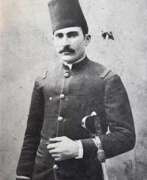

Abdul Qadir Al Rassam was an Iraqi painter of the first half of the twentieth century. He is known as a painter and graphic artist and is considered the founder of modern Iraqi painting.
Al Rassam, a military officer by training, studied drawing at the Military College in Istanbul. Returning to Iraq, he created landscapes, portraits and murals. His work is characterized by historical and ethnographic accuracy. The master, according to critics, contributed to the influence of the European academic school on the Iraqi art scene.


Manuel Khristoforovich Alajalov (Russian: Мануил Христофорович Аладжалов) was a prominent Russian and Soviet landscape painter and educator, born in 1862 in Nakhichevan-on-Don. Alajalov's work is distinguished by his exquisite landscapes that capture the essence of the Russian countryside. His paintings are noted for their masterful use of light and shadow, bringing a serene and lifelike quality to his depictions of nature.
Alajalov's career was marked by a deep commitment to portraying the natural world with authenticity and emotion. His art reflects a profound appreciation for the tranquility and beauty of rural Russia, making him a significant figure in the history of Russian art. Alajalov's legacy as a teacher also influenced many aspiring artists of his time, further cementing his place in the artistic community.
Alajalov's works are showcased in several major Russian museums, including the State Tretyakov Gallery, where art enthusiasts can experience his contribution to landscape painting. His paintings continue to be celebrated for their technical excellence and emotional depth, attracting collectors and admirers from around the world.
For updates on new product sales and auction events related to Manuel Khristoforovich Alajalov, sign up for our newsletter. Stay informed about exclusive opportunities to own a piece of this celebrated artist's legacy.


Jean-François Albanis Beaumont was a French landscape painter, engineer, traveler and geographer.
He studied engineering in Paris and worked on architectural structures at Chambérly. Beaumont later accompanied the Duke of Gloucester, William Frederick of Hanover on a grand tour of Germany, Italy, France, and Switzerland, making notes and detailed pictorial sketches of views along the way. In 1800 he published the illustrated books Journey to the Lepontine Alps from France to Italy and Description of the Grecian and Cottian Alps (1802 and 1806).


Kazimierz Alchimowicz was a Polish painter who is considered one of the last Romantics in Polish painting. Among other things, he illustrated Adam Mickiewicz's poem Pan Tadeusz with a series of twelve paintings (1898) and prints (1903). He was the elder brother of the Polish painter Hiacynt Alchimowicz.


Antonio Ambrogio Alcati was an Italian academic painter, portraitist, master of frescoes and teacher. He studied painting at the Vercelli Institute of Fine Arts and the Brera Academy of Fine Arts.
Ambrogio Alcati's work is also influenced by Impressionism.




William Alexander was a British painter, illustrator and printmaker.
He studied painting at the Royal Academy and became a very famous artist. In 1792-1794 he accompanied the official embassy to Peking of Lord George Macartney on behalf of the British government, where he documented the visit and made many drawings of the Chinese court. These depict various mandarins, merchants, members of the royal family and members of Chinese society. In 1805, William Alexander published Costume of China, an album illustrated with 48 color prints, which was a success with the public.


Henry Thomas Alcken was an English painter and engraver chiefly known as a caricaturist and illustrator of sporting subjects and coaching scenes. His most prolific period of painting and drawing occurred between 1816 and 1831.
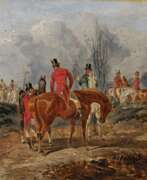

Samuel Henry Alken the Younger was a British painter.
Samuel Henry Alken was the son of Henry Thomas Alken (1785-1851) and grandson of Samuel Alken Senior (1756-1815). Like his father, he usually depicted equestrian sporting scenes, but did so in sets. The most famous of the sets of paintings by Henry Alken, Jr. is a depiction of hunting at Belvoir Castle.


August Allebé was an artist and teacher from the Northern Netherlands. His early paintings were in a romantic style, but in his later work he was an exponent of realism and impressionism. He was a major initiator and promoter of Amsterdam Impressionism, the artist's association St. Lucas, and the movement of the Amsterdamse Joffers. Amsterdam Impressionism – sometimes referred to by art historians as the School of Allebé – was the counterflow to the very strong Hague School in the movement of Dutch Impressionism. As a professor at the Royal Academy of Amsterdam (Rijksakademie van beeldende kunsten) he fostered a cosmopolitan attitude toward art and the promotion and motivation of his students, and provided a significant stimulus to developments in modern art.


William Herbert Allen was an English landscape watercolour artist whose career spanned more than 50 years from the 1880s to the 1940s. He was invariably referred to as «W. H.» rather than by his given name. He produced several thousand watercolours, chalk and pencil sketches mainly of the landscapes, traditions and people of West Surrey and North-east Hampshire. In addition, he produced scenes of other parts of the British Isles and various parts of continental Europe. These works included commissions in Italy for the Victoria and Albert Museum, Dublin, Edinburgh and Preston museums. He was made a member of the Royal Watercolour Society in 1903 and the Royal Society of British Artists in 1904 and his work was exhibited at the Royal Academy in 1927.


Lawrence Alma-Tadema was a Dutch-British artist renowned for his detailed and romanticized portrayals of ancient civilizations, particularly Rome and Egypt. His meticulous attention to historical accuracy and the lavish representation of marble and luxurious settings distinguished his work. Notably, his fascination with ancient cultures was sparked by his honeymoon visit to Italy and Pompeii, influencing his artistic focus for decades.
Lawrence Alma-Tadema's early work, such as "The Education of the Children of Clovis," showcased his interest in historical subjects and established his reputation. This painting, alongside others like "The Sad Father," demonstrates his commitment to historical detail and narrative depth.
After moving to England due to the Franco-Prussian War and personal reasons, Lawrence Alma-Tadema's career flourished. His works, characterized by their bright palette and refined details, resonated with Victorian audiences, earning him considerable fame and financial success. He was knighted in 1899 and continued to be a pivotal figure in Victorian art, influencing peers and future generations alike.
Lawrence Alma-Tadema's legacy experienced a decline posthumously but saw a resurgence in the 1970s. Today, he is celebrated for his contributions to the Neoclassical and Victorian art movements, with his works featured in prominent collections worldwide, including the Getty Museum and the Tate Gallery.
If you are fascinated by Lawrence Alma-Tadema's artwork and wish to stay updated on sales and auction events related to his works, consider signing up for updates. This will ensure you remain informed about new opportunities to explore and possibly acquire pieces of his illustrious legacy.
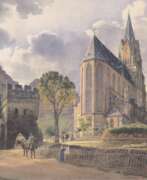

Jakob Alt was an Austrian landscape painter, graphic artist and lithographer. He studied painting at the Vienna Academy of Fine Arts.
He travelled extensively through the Austrian Alps and the Danube regions, painting landscapes. For 5 years he lived and worked in Italy. During his travels the artist also collected an extensive herbarium, which is now preserved in the Provincial Museum of Lower Austria.


Otto Altenkirch was a German impressionist painter and stage designer. He studied at the Berlin University of the Arts and the Dresden Academy of Fine Arts.
Otto Altenkirch was one of the founders of the Künstlervereinigung Dresden, one of the artists who worked at the Dresden Museum and the Opera House.
For two decades one of his favourite subjects was the linden alley in Rheinsberg. In 1941 and 1943 his works were exhibited in the Große Deutsche Kunstausstellung (exhibition of Nazi-approved art in Munich).


Wilhelm Amberg was a German genre painter. He was educated by the painters Carl Joseph Begas in Berlin and Léon Cogniet in Paris (1845). After this he spent a couple of years in Rome. His paintings are characterized by humour and a poetic atmosphere.
Wilhelm Amberg has won many awards and from 1886 was a Member of the Senate of the Prussian Academy of Arts, Berlin.


Gustav Adolf Amberger was a German painter and graphic artist. He lived in Rome for two years and learned the painting trade from Peter von Cornelius. One of his first works was the painting The Oceanides. Amberger worked as a designer in the ribbon factory founded by Philipp Trüdinger. Around 1870 he was the court painter to the Landgrave of Hesse. In Antwerp he was a pupil of Joseph van Lerius and made numerous copies, of which Les deux voies is the best known.


Samuel Amsler is a Swiss engraver. He studied his art under Johan Heinrich Lips and Karl Ernst Hess, at Munich, and from 1816 pursued it in Italy, and chiefly at Rome, till in 1829 he succeeded his former master Hess as professor of engraving in the Munich academy. The works he designed and engraved are remarkable for the grace of the figures, and for the wonderful skill with which he retains and expresses the characteristics of the original paintings and statues. He was a passionate admirer of Raphael, and had great success in reproducing his works.


Auguste Anastasi is a French landscape painter of the Barbizon School.
Auguste Anastasi was a student of Paul Delaroche and Jean-Baptiste Corot. He painted landscapes around Paris, Normandy, Holland and Italy, in Rome and especially in Naples, but also in the Tyrol, of which he also made lithographs.


Sophie Gengembre Anderson was a British artist of French descent.
Fleeing the revolution in France, her family moved to the United States in 1848, and Sophie had a successful career in America for several years. She specialized in genre and portrait paintings depicting children and women, usually in rural settings.
In 1854 the Andersons moved to London and Sophie's work was well received and exhibited widely at the Royal Academy, the Royal Society of British Artists (RBA) and the British Institution.


Louise Elisabeth Andrae was a German Post-Impressionist landscape painter and watercolorist. She studied with two landscape painters; Gustav Adolf Thamm in Dresden and Hans von Volkmann in Karlsruhe. She settled in Dresden, but spent long periods on the island of Hiddensee. There, she helped organize a group known as the Hiddensoer Künstlerinnenbund, an association of women artists that included Clara Arnheim, Elisabeth Büchsel, Käthe Loewenthal and Katharina Bamberg. They were regular exhibitors at an art venue known as the Blaue Scheune (Blue Barn), established in 1920 by Henni Lehmann. She also exhibited frequently with a group known as the Kunstkaten in Ahrenshoop.Wikipedia






























